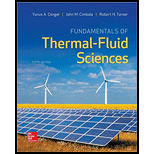
Concept explainers
(a)
The rate of heat transfer through the wall.
(a)
Explanation of Solution
Given:
Thickness of the wall is 0.22 m.
Height of the wall is 5 m.
Length of the wall is 8 m.
Temperature at the left surface of the wall is
Temperature at the right surface of the wall is
Calculation:
The total thermal resistance of the arrangement is,
The rate of heat transfer through the wall per
The total rate of heat transfer through the entire wall is,
Thus, the rate of heat transfer through the wall is
(b)
The temperature at the meeting point of sections B, D and E.
(b)
Explanation of Solution
Calculation:
The thermal resistance at left of the meeting point of sections B, D and E is,
The temperature at the meeting point of sections B, D and E is,
Thus, the temperature at the meeting point of sections B, D and E is
(c)
The temperature drop across section F.
(c)
Explanation of Solution
Calculation:
Calculate the temperature drop across section F.
Thus, the temperature drop across section F is
Want to see more full solutions like this?
Chapter 17 Solutions
Fundamentals of Thermal-Fluid Sciences
 Elements Of ElectromagneticsMechanical EngineeringISBN:9780190698614Author:Sadiku, Matthew N. O.Publisher:Oxford University Press
Elements Of ElectromagneticsMechanical EngineeringISBN:9780190698614Author:Sadiku, Matthew N. O.Publisher:Oxford University Press Mechanics of Materials (10th Edition)Mechanical EngineeringISBN:9780134319650Author:Russell C. HibbelerPublisher:PEARSON
Mechanics of Materials (10th Edition)Mechanical EngineeringISBN:9780134319650Author:Russell C. HibbelerPublisher:PEARSON Thermodynamics: An Engineering ApproachMechanical EngineeringISBN:9781259822674Author:Yunus A. Cengel Dr., Michael A. BolesPublisher:McGraw-Hill Education
Thermodynamics: An Engineering ApproachMechanical EngineeringISBN:9781259822674Author:Yunus A. Cengel Dr., Michael A. BolesPublisher:McGraw-Hill Education Control Systems EngineeringMechanical EngineeringISBN:9781118170519Author:Norman S. NisePublisher:WILEY
Control Systems EngineeringMechanical EngineeringISBN:9781118170519Author:Norman S. NisePublisher:WILEY Mechanics of Materials (MindTap Course List)Mechanical EngineeringISBN:9781337093347Author:Barry J. Goodno, James M. GerePublisher:Cengage Learning
Mechanics of Materials (MindTap Course List)Mechanical EngineeringISBN:9781337093347Author:Barry J. Goodno, James M. GerePublisher:Cengage Learning Engineering Mechanics: StaticsMechanical EngineeringISBN:9781118807330Author:James L. Meriam, L. G. Kraige, J. N. BoltonPublisher:WILEY
Engineering Mechanics: StaticsMechanical EngineeringISBN:9781118807330Author:James L. Meriam, L. G. Kraige, J. N. BoltonPublisher:WILEY





